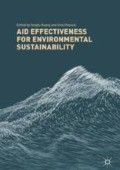Abstract
A companion to the previous chapter, Chap. 9 by Pekka Kauppi looks at how forestry aid has evolved over time, from the emphasis of foreign aid to incentivize industrial forestry in the 1960s to the new focus on REDD+ during the last decade, and argues that while investments in forestry have been associated with the value of timber as a global commodity, environmental and social concerns still remain. Kauppi discusses the history, scalability and transferability of tree planting and initiatives aimed at improving cooking stoves to save trees and to improve human health. He also points towards the important role of local universities in catalysing research towards forest conservation in developing countries, especially in Africa where university education is limited.
Notes
- 1.
Personal correspondence with Erkki Tomppo.
References
Angelsen, A. 2009. Policy Options to Reduce Deforestation. In Realising REDD+: National Strategy and Policy Options, ed. A. Angelsen. Bogor: CIFOR.
Ausubel, J.H., I.K. Wernick, and P.E. Waggoner. 2013. Peak Farmland and the Prospect for Land Sparing. Population and Development Review 38 (Suppl): 217–238.
Defries, R.S., T. Rudel, M. Uriarte, and M. Hansen. 2010. Deforestation Driven by Urban Population Growth and Agricultural Trade in the Twenty-first Century. Nature Geoscience 3 (3): 178–181.
Goodale, C.L., M. Apps, R. Birdsey, C. Field, L. Heath, R. Houghton, J. Jenkins, G. Kohlmaier, W. Kurz, S. Liu, G. Nabuurs, S. Nilsson, and A. Shvidenko. 2002. Forest Carbon Sinks in the Northern Hemisphere. Ecological Applications 12 (3): 891–899.
Hayward, F.M. 2012. Graduate Education in Sub-Saharan Africa: Prospects and Challenges. International Higher Education 66: 21–22.
Houghton, R.A. 2003. Revised Estimates of the Annual Net Flux of Carbon to the Atmosphere from Changes in Land Use and Land Management 1850–2000. Tellus B 55: 378–390.
Kauppi, P.E., J.H. Ausubel, J. Fang, A.S. Mather, R.A. Sedjo, and P.E. Waggoner. 2006. Returning Forests Analyzed with the Forest Identity. Proceedings of the National Academy of Sciences 103 (46): 17574–17579.
Lambin, E.F., and P. Meyfroidt. 2011. Global Land Use Change, Economic Globalization, and the Looming Land Scarcity. Proceedings of the National Academy of Sciences of the United States of America 108 (9): 3465–3472.
Lambin, E.F., B.L. Turner, H.J. Geist, S.B. Agbola, A. Angelsen, J.W. Bruce, O.T. Coomes, et al. 2001. The Causes of Land-use and Land-cover Change: Moving Beyond the Myths. Global Environmental Change 11 (4): 261–269.
Mather, A.S. 2007. Recent Asian Forest Transitions in Relation to Forest-transition Theory. International Forestry Review 9: 491–502.
Mather, A.S., and C. Needle. 1998. The Forest Transition: A Theoretical Basis. Area 30: 117–124.
Meyfroidt, P., and E.F. Lambin. 2008. The Causes of the Reforestation in Vietnam. Land Use Policy 25 (2): 182–197.
Michaelson, M. 1994. Wangari Maathai and Kenya’s Green Belt Movement: Exploring the Evolution and Potentialities of Consensus Movement Mobilization. Social Problems 41 (4): 540–561.
Moyo, D. 2006. Dead Aid. Why Aid Is Not Working and How There Is a Better Way for Africa. New York: Farrar, Straus and Giroux.
Niu, X., B. Wang, S. Liu, C. Liu, W. Wei, and P.E. Kauppi. 2012. Economical Assessment of Forest Ecosystem Services in China: Characteristics and Implications. Ecological Complexity 11: 1–11.
Pan, Y., R.A. Birdsey, J. Fang, R. Houghton, P.E. Kauppi, W.A. Kurz, O.L. Phillips, A. Shvidenko, S.L. Lewis, J.G. Canadell, P. Ciais, R.B. Jackson, S. Pacala, A.D. McGuire, S. Piao, A. Rautiainen, S. Sitch, and D. Hayes. 2011. A Large and Persistent Carbon Sink in the World’s Forests. Science 333: 988–983.
Persson, R. 2003. Assistance to Forestry: Experiences and Potential for Improvement. Bogor: CIFOR.
Rautiainen, A., I. Wernick, P.E. Waggoner, J.H. Ausubel, and P.E. Kauppi. 2011. A National and International Analysis of Changing Forest Density. PloS One 6 (5): e19577. https://doi.org/10.1371/journal.pone.0019577.
Rudel, T.K., O.T. Coomes, E. Moran, F. Achard, A. Angelsen, J. Xu, and E. Lambin. 2005. Forest Transitions: Towards a Global Understanding of Land Use Change. Global Environmental Change 15: 23–31.
———. 2013. Defensive Environmentalists and the Dynamics of Global Reform. New York and Cambridge: Cambridge University Press.
Saikku, L., S. Soimakallio, and K. Pingoud. 2012. Attributing Land-use Change Carbon Emissions to Exported Biomass. Environmental Impact Assessment Review 37: 47–54.
Sedjo, R.A. 1999. The Potential of High-Yield Plantation Forestry for Meeting Timber Needs: Recent Performance, Future Potentials, and Environmental Implications. New Forests 17: 339–359.
Soulé, M.E., and B.A. Wilcox. 1980. Conservation Biology: An Evolutionary-Ecological Perspective. Sunderland: Sinauer Associates.
UN/FAO. 2000. Global Forest Resources Assessment 2000. Main Report. Forestry Paper 140. Rome: Food and Agriculture Organization of the United Nations.
———. 2010. Global Forest Resources Assessment 2010: Main Report. Forestry Paper 163. Rome: Food and Agriculture Organization of the United Nations.
Vanhanen, M. 2012. ENO’s Final Breakthrough in Rio+ Summit. http://www.uncsd2012.org/content/documents/790Summary%20of%20Voluntary%20Commitments%20Registered%20at%20Rio20%20v6.pdf. Accessed 17 October 2013.
Wilson, E.O., and F.M. Peter, eds. 1988. Biodiversity. Washington, DC: National Academy Press.
Author information
Authors and Affiliations
Editor information
Editors and Affiliations
Rights and permissions
Copyright information
© 2018 UNU-WIDER
About this chapter
Cite this chapter
Kauppi, P.E. (2018). The Evolution, Paradigm Shift and Guidelines for Foreign Aid in Forestry. In: Huang, Y., Pascual, U. (eds) Aid Effectiveness for Environmental Sustainability. Palgrave Macmillan, Singapore. https://doi.org/10.1007/978-981-10-5379-5_9
Download citation
DOI: https://doi.org/10.1007/978-981-10-5379-5_9
Published:
Publisher Name: Palgrave Macmillan, Singapore
Print ISBN: 978-981-10-5378-8
Online ISBN: 978-981-10-5379-5
eBook Packages: Earth and Environmental ScienceEarth and Environmental Science (R0)

